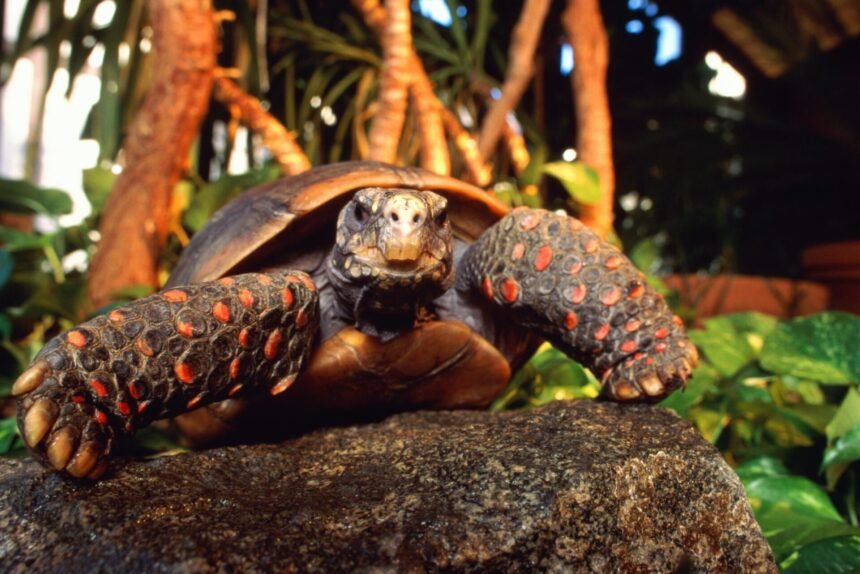Have you ever seen a splash of ruby red against the lush green rainforest floor? The red-footed tortoise is a vibrant jewel amidst the rainforest’s treasures. Yet, this captivating creature, known for its slow pace and charming personality, faces challenges in its ever-changing world.
⫸ Unveiling the Red-footed Tortoise
Discover the enchanting world of the red-footed tortoise, a charismatic reptile that adds a splash of color to the depths of the rainforest. With their vibrant markings and lifespan rivaling a human’s, this species offers a unique glimpse into nature’s design. In this article, we’ll unveil the secrets of this captivating creature, exploring its origin, anatomy, and challenges.
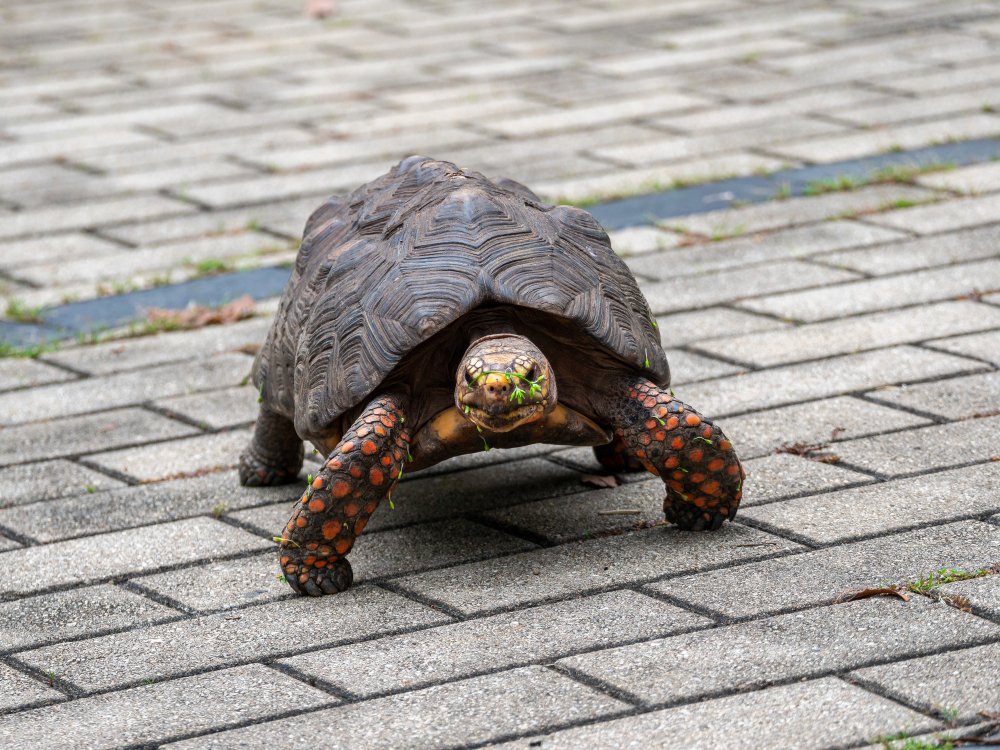
Geographic Origins: Rainforest Royalty:
● South American Splendor: Exploring the Range:
The red-footed tortoise reigns over a wide swath of South America, including countries like Brazil, Colombia, Argentina, and Venezuela. Their range extends into various tropical and subtropical habitats within these nations, from the depths of lush rainforests to the edges of savannas. This remarkable adaptability speaks to the red-footed tortoise’s enduring nature.
● Lush Life: Adapting to the Rainforest Environment:
The rainforest, a complex web of life, shapes the habits of this tortoise. These tortoises rely on the dense foliage for shelter and camouflage, while the humid conditions keep their skin healthy. Their adaptability helps them thrive in this rich environment despite its challenges.
A Shell-ebration of Anatomy:
● Shell Splendor: A Look at the Carapace and Plastron:
Like all tortoises, the red footed tortoise is encased in a protective shell formed by the fusion of its ribs and spine. This dome-like structure is the carapace (top shell), while the flat underside is the plastron. The shell provides unparalleled defense against the dangers of the rainforest.
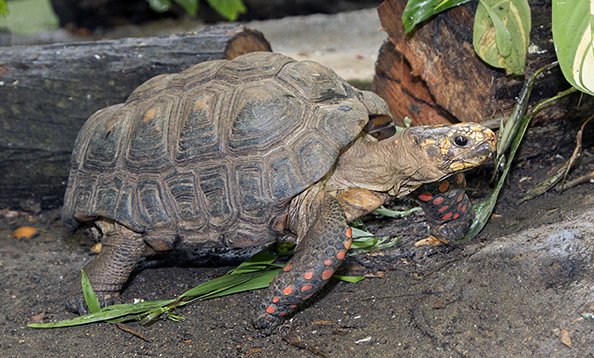
● Distinguished Markings: The Red-Footed Signature:
The red footed tortoise gets its name from the vibrant scales often adorning its legs, head, and tail. These colors can range from yellow to fiery red. Each tortoise’s pattern is unique, with black or dark brown scales forming a striking contrast against the vivid hues.
● Size Matters: Unveiling Sexual Dimorphism:
Male tortoises tend to be larger than their female counterparts. Additionally, males have a concave plastron, while females’ plastrons are flatter. These subtle differences, known as sexual dimorphism, affect their mating behaviors. Understanding such differences helps us appreciate the intricate variations within this species.
⫸ Unveiling the Secrets of the Red-footed Tortoise
Unraveling the mysteries of the rainforest often leads to remarkable discoveries, and the red footed tortoise is one such treasure. This fascinating reptile, known for its striking colors and intriguing behavior, holds a special place in South America’s rich biodiversity. Let’s dive into their world and explore the secrets that make them unique.
A Life Lived Low and Slow: Understanding Red-footed Tortoise Behavior:
This tortoises aren’t known for their speed. Their deliberate movements and seemingly laid-back lifestyle reflect adaptations critical to their survival. These gentle creatures usually spend their days foraging, basking in the sun, or seeking shelter. While they may appear solitary, social interactions exist, especially during mating.
● Shedding Light on Daily Routines:
A typical day for a red-footed tortoise revolves around finding food and maintaining a comfortable body temperature. Foraging takes up a significant part of their day, followed by periods of rest or thermoregulation (sunbathing or seeking shade).
● Hibernation Habits: A Time for Rest and Renewal:
In areas experiencing dry seasons, red-footed tortoises may enter a dormancy called estivation. This allows them to conserve energy and survive limited food and water periods. They often burrow underground, where they remain inactive until conditions improve.
A Culinary Adventure: The Red-footed Tortoise Diet:
Red-footed tortoises are primarily herbivorous, but their tastes are surprisingly diverse. Let’s explore their rainforest menu:
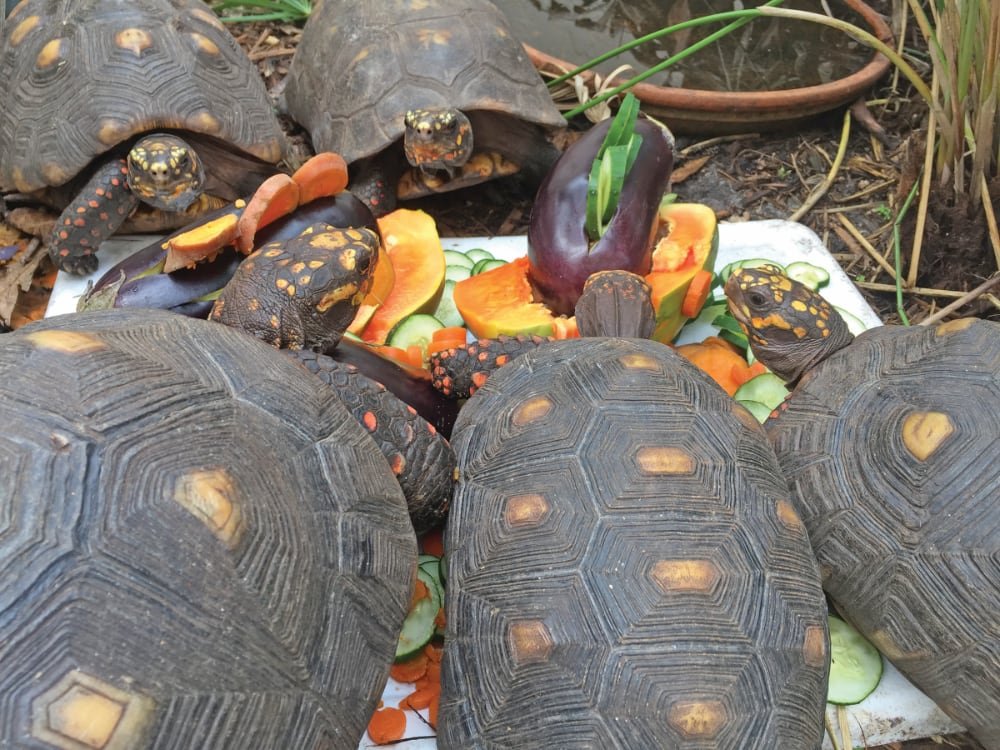
● From Fungus to Fruit: A Diverse Menu:
Fallen fruits, flowers, leaves, grasses, and fungi form the backbone of their diet. They are opportunistic feeders, occasionally scavenging carrion or consuming snails for extra protein and calcium.
● The Importance of Hydration:
Staying hydrated is crucial for red-footed tortoises. They drink water from puddles or dew and even absorb moisture through their skin. Their diet of succulent fruits and plants also contributes to their water intake.
● Seasonal Shifts in Feeding Patterns:
A red-footed tortoise’s diet adapts to the rainforest’s rhythm. During wet seasons, an abundance of fruits and vegetation is available. However, dry seasons mean they may rely more on fungi and tougher plant matter.
The Circle of Life: Reproduction and Hatchling Development:
Ensuring future generations is vital for any species. Let’s examine how red-footed tortoises ensure their legacy:
● Mating Rituals: A Dance of Attraction:
Red-footed tortoise courtship involves head bobbing, biting, and circling behaviors by the male. Competition for females can be stiff, occasionally resulting in bouts of shell-ramming.
● Nest Building and Egg-Laying:
Female red-footed tortoises carefully excavate nests in soft ground where they lay 2-15 eggs clutches. Nest sites are often chosen for warmth and moisture, which are crucial for incubation.
● The Long Journey to Hatching:
Incubation takes a long time, ranging from 100 to 200 days. Hatchlings emerge fully equipped for life, though they remain vulnerable to predators until their shells harden.
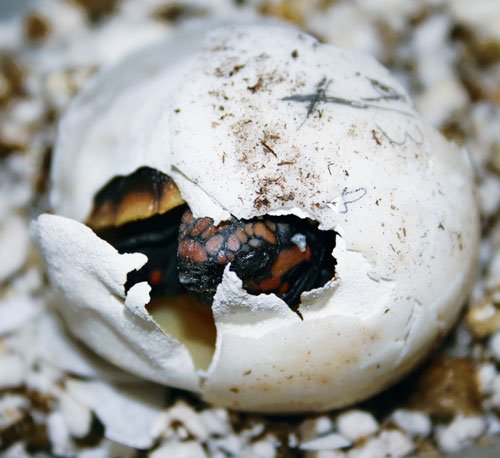
⫸ Life in the Rainforest: A Paradise for Red-Footed Friends
The rainforest, a tapestry of vibrant life, provides the perfect haven for the captivating red-footed tortoise. These striking reptiles find everything they need amidst this unique ecosystem’s lush greenery and ever-changing seasons. Let’s delve into how the red-footed tortoise thrives within its rainforest paradise.
Rainforest Rhapsody: Adapting to a Lush Habitat:
Their iconic shells, combining dark hues and warm yellows, provide ideal camouflage amidst the dappled sunlight and fallen leaves. This and their slow, deliberate movements help them blend in with the forest floor. They are masters at regulating their body temperature, seeking the warmth of sunbeams on cool mornings and retreating to the shade during the day’s heat. When humidity drops, they find moist microhabitats or burrow into the ground to conserve moisture.
● Gearing Up for the Green Feast: Dietary Delights:
The red-footed tortoise is a true rainforest gourmand, and its diet is a vibrant reflection of its surroundings. Fallen fruit, lush leaves, colorful mushrooms, and occasional snail or insect provide a diverse feast. Their sense of smell is vital for locating their favorite food sources across the forest floor.
● Sheltering from the Storm: Finding Refuge in the Rainforest:
Safety in the wild is key, and the red-footed tortoise has its strategies. Their sturdy shells offer protection from many predators. When threatened, they retreat into their shells, leaving little for an attacker to grasp. As the seasons shift, they seek out burrows or piles of leaves to shelter from the elements and hibernate when temperatures drop.
Social Butterflies or Tortoises?
While not exactly the epitome of gregariousness, red-footed tortoises exhibit fascinating social interactions. Though they may wander solo, they occasionally gather in groups, especially around rich food sources. During the breeding season, males engage in combat rituals, such as shoving and head-butting, to establish dominance and to impress potential mates. Yet, outside of the mating season, they exhibit tolerance rather than outright aggression toward one another.
● Courtship Customs: The Ritual of Romance:
When love is in the air, male red-footed tortoises become surprisingly animated. Bobbing heads, circling dances, and biting a female’s legs are all part of their quirky courtship displays. If she’s impressed, mating occurs, and a few months later, she’ll dig a nest to lay a clutch of eggs. Her parenting duties end there, leaving the nest buried and the future generation entirely alone.
● From Egg to Explorer: Witnessing Hatchling Development:
After a lengthy incubation, tiny red-footed tortoise hatchlings emerge from their buried nest – miniature versions of their parents but with brighter shells. They are immediately independent, their instinct for survival guiding them. The rainforest presents dangers everywhere, from hungry predators to the elements. Their shells offer protection, but camouflage and cautious behavior are essential for the young tortoises to reach maturity – a feat only a small percentage achieve.
⫸ Threats and Conservation Efforts: The Red-footed Tortoise's Fight for Survival
The red-footed tortoise, a vibrant resident of the South American rainforest, faces a complex web of threats jeopardizing its long-term survival. Understanding these dangers is crucial for appreciating the urgent need for conservation measures to protect this rainforest gem.
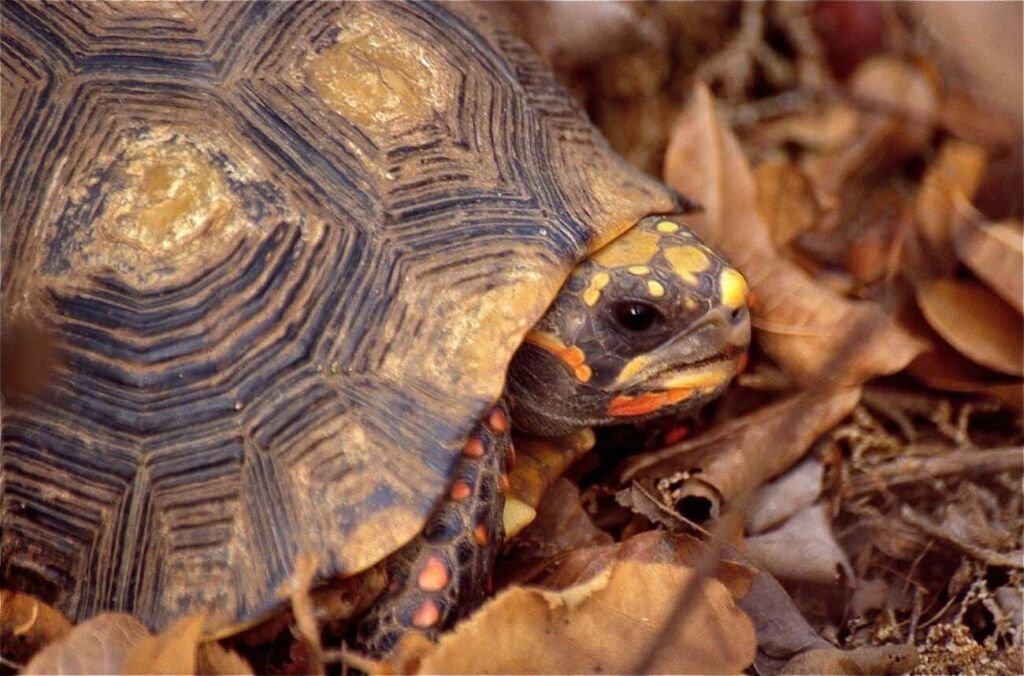
Facing the Challenges: Threats to Red-footed Tortoise Populations:
- Habitat Loss: A Looming Threat: Deforestation and conversion of rainforests for agriculture and development destroy the tortoise’s home. This fragmentation isolates populations and reduces resources for survival.
- The Illicit Pet Trade: A Cause for Concern: Their unique beauty makes red-footed tortoises targets for illegal collection for the pet trade. This unsustainable practice removes individuals from breeding populations, further threatening the species.
- Facing Predators: Natural and Introduced Threats: Natural predators like jaguars are part of the ecosystem. However, introduced species like dogs and cats can create excess pressure on tortoise populations, especially vulnerable hatchlings.
Vulnerable Jewels: Predators and Perils
● Habitat Heroes or Habitat Hazards? Human Impact
Human actions drastically reshape the landscapes on which red-footed tortoises depend. Uncontrolled fires from land clearing damage their habitat and leave them vulnerable. Road construction leads to fragmentation and increases the risk of fatal vehicle strikes. Pollution from agricultural runoff further compromises the fragile rainforest ecosystem these tortoises rely on.
Conservation Champions: Protecting the Red-footed Future
Despite the challenges, dedicated conservation efforts create hope for the red-footed tortoise’s future. These initiatives focus on several key areas:
- Protecting Rainforest Homes: Creating protected reserves and sustainable land-use practices helps protect vital red-footed tortoise habitat. These areas safeguard the tortoises and the entire intricate rainforest ecosystem they comprise.
- Captive Breeding Programs: A Beacon of Hope: Zoos and conservation organizations operate controlled breeding programs that increase the number of red-footed tortoises. These efforts boost populations and can facilitate the reintroduction of tortoises into depleted areas.
- Empowering Local Communities: Guardians of the Rainforest: Educating and engaging local communities is vital to red-footed tortoise conservation. By understanding the intrinsic value of the rainforest and sustainable practices, these communities become powerful allies in protecting the tortoise and its habitat.
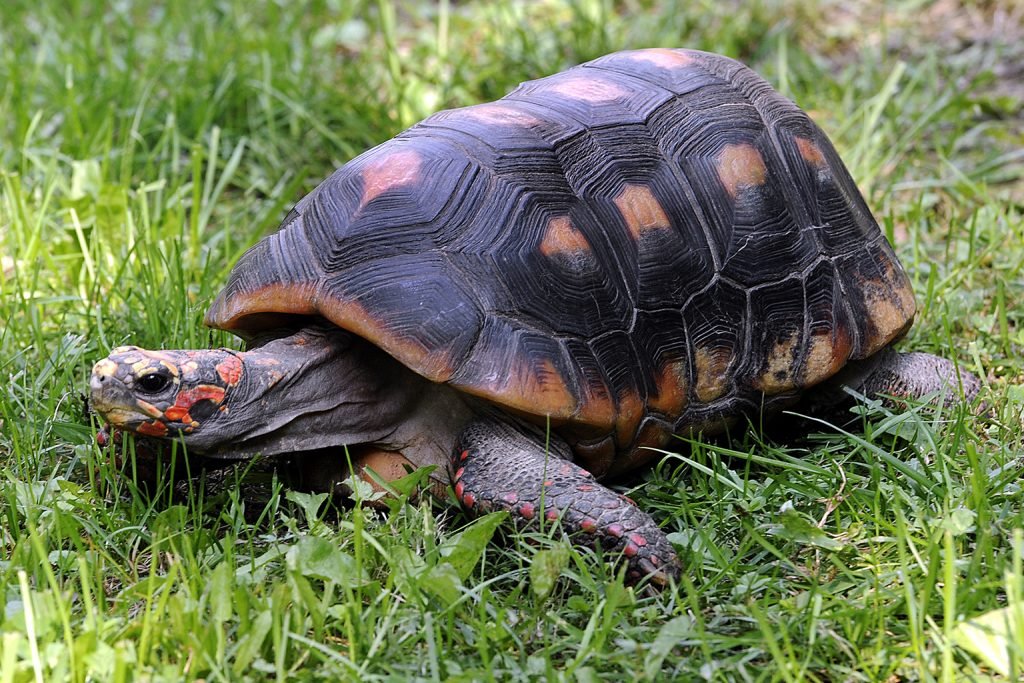
⫸ Captivating the Red-footed Tortoise: A World Within Your Reach
The red-footed tortoise, with its vibrant markings and curious nature, holds a special allure. While seeing them thrive in their natural habitat is undeniably special, bringing these rainforest gems home raises questions about ethics and responsibility. Let’s delve into caring for a red-footed tortoise in captivity and appreciating their role in the wild.
Considering Captivity: The Responsibility of Ownership
Before embracing the idea of red-footed tortoise ownership, it’s vital to understand their complex needs. These long-lived creatures require a spacious, humidity-rich environment miming their rainforest home. Are you committed to providing this specialized care throughout their life, potentially spanning decades? Research reputable breeders and be prepared for the financial investment in their long-term well-being.
● Creating a Rainforest Paradise at Home
A red-footed tortoise needs more than just a tank. Design a large, multi-level enclosure with suitable substrate, hiding spots, and temperature and humidity gradients. Offer a varied diet mirroring their rainforest foraging, including leafy greens, fruits, vegetables, and occasional protein sources. Regular vet checkups are essential for their health.
● Dietary Decisions: Providing the Perfect Feast
A balanced diet is key for a thriving red-footed tortoise. Offer a mix of leafy greens, vegetables, fruits, and occasional protein sources, ensuring calcium supplementation to support their strong shell.
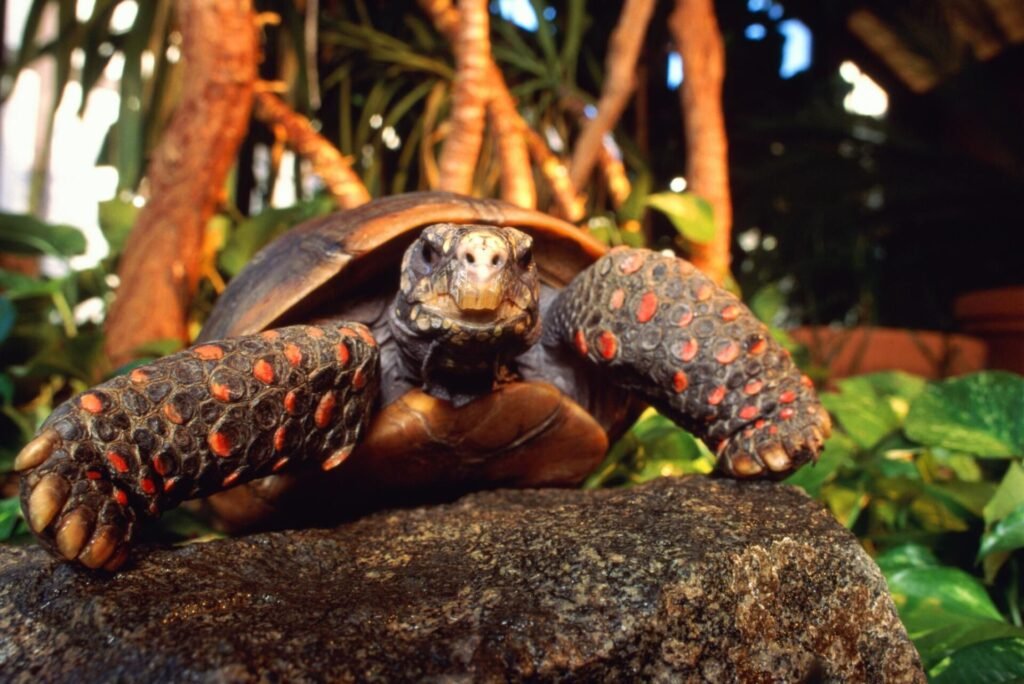
Beyond the Enclosure: Appreciating Red-Footed Tortoises in the Wild
Witnessing red-footed tortoises in their South American forest home is an unforgettable experience. It highlights their vital role within the delicate rainforest ecosystem. However, these wild populations face threats like habitat loss and the illegal pet trade. How can you support them?
● Ecotourism Adventures: Witnessing Rainforest Wonders
Support ecotourism ventures committed to sustainable practices. Seek tour operators that minimize environmental impact and contribute to local conservation efforts. By responsibly witnessing red-footed tortoises in their natural habitat, you directly support their protection and learn firsthand about the importance of preserving these unique rainforest creatures.
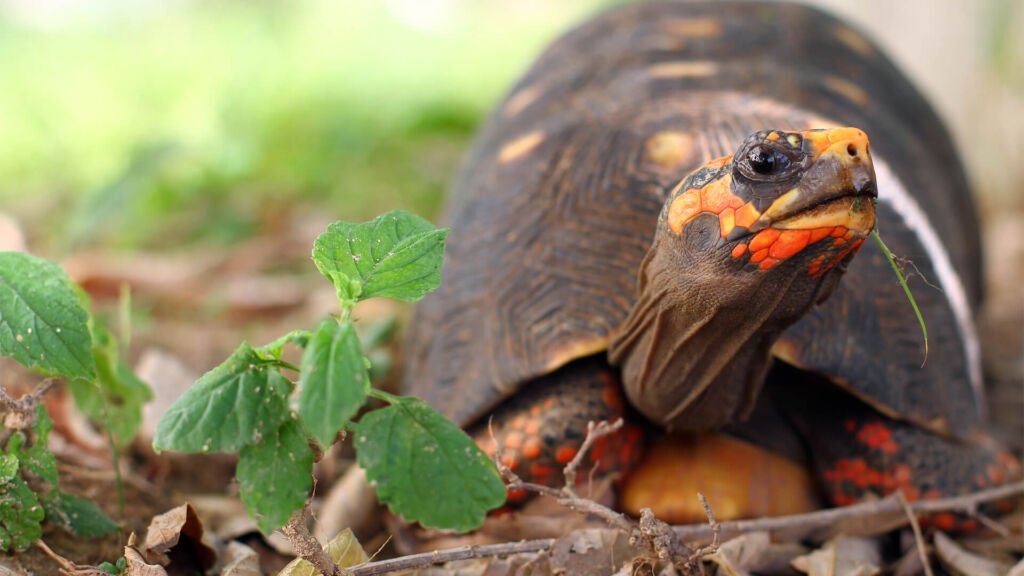
● Responsible Tourism: Ensuring a Sustainable Future
Choose ecotourism operators that prioritize conservation, educate tourists, and support local communities that depend on the rainforest for their livelihood. Your responsible choices help ensure the continued survival of the red-footed tortoise and the delicate ecosystem it inhabits.
⫸ Conclusion: The Enduring Legacy of the Red-footed Tortoise
The red-footed tortoise, a vibrant rainforest icon, plays a vital role within its delicate ecosystem. As seed dispersers and natural forest engineers, their presence is essential for rainforest health. Yet, habitat destruction and unsustainable practices threaten their future. By supporting conservation efforts, promoting responsible ecotourism, and spreading awareness, we can help secure a future where the red-footed tortoise continues to grace the rainforest floor. Their enduring legacy lies in our hands.

